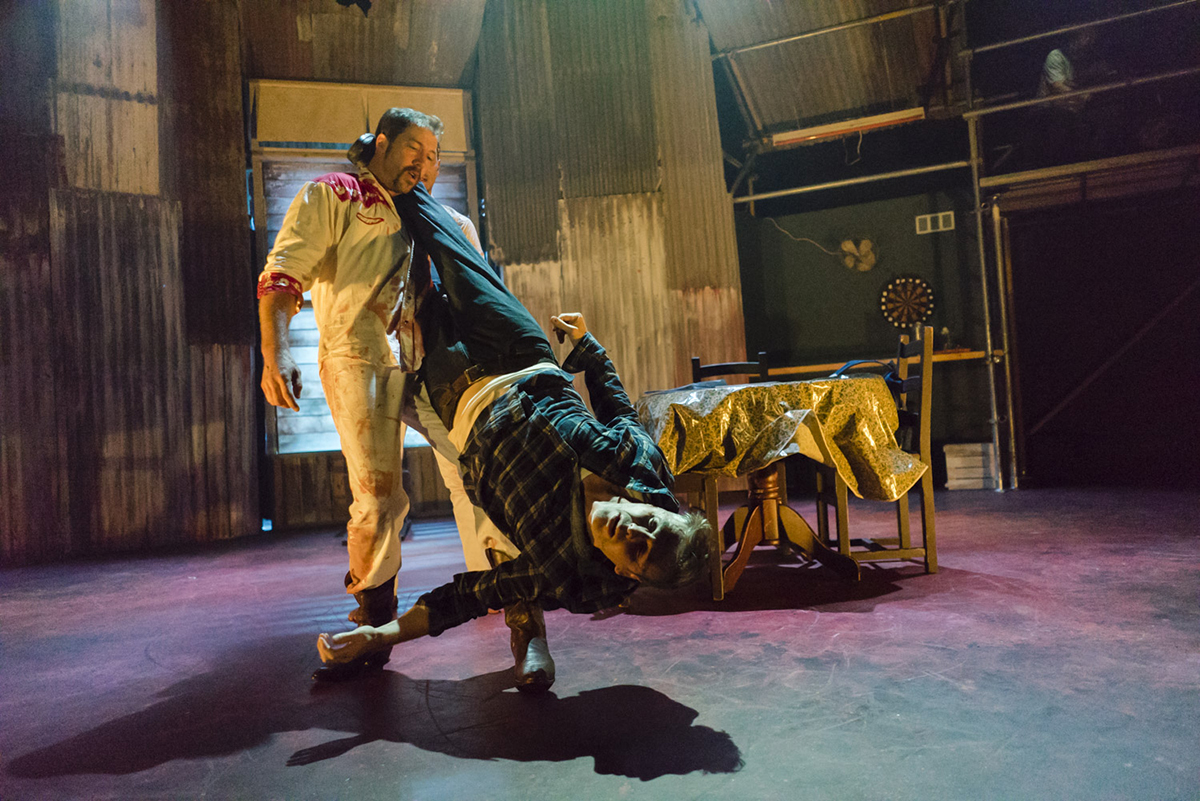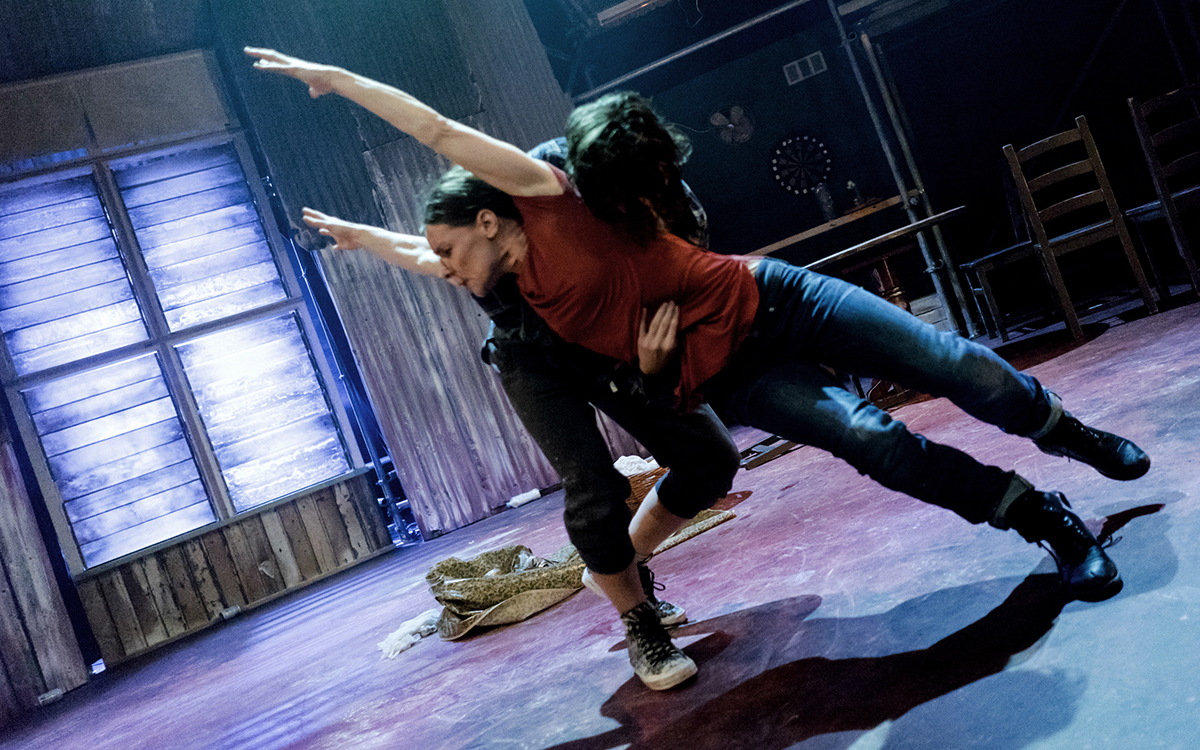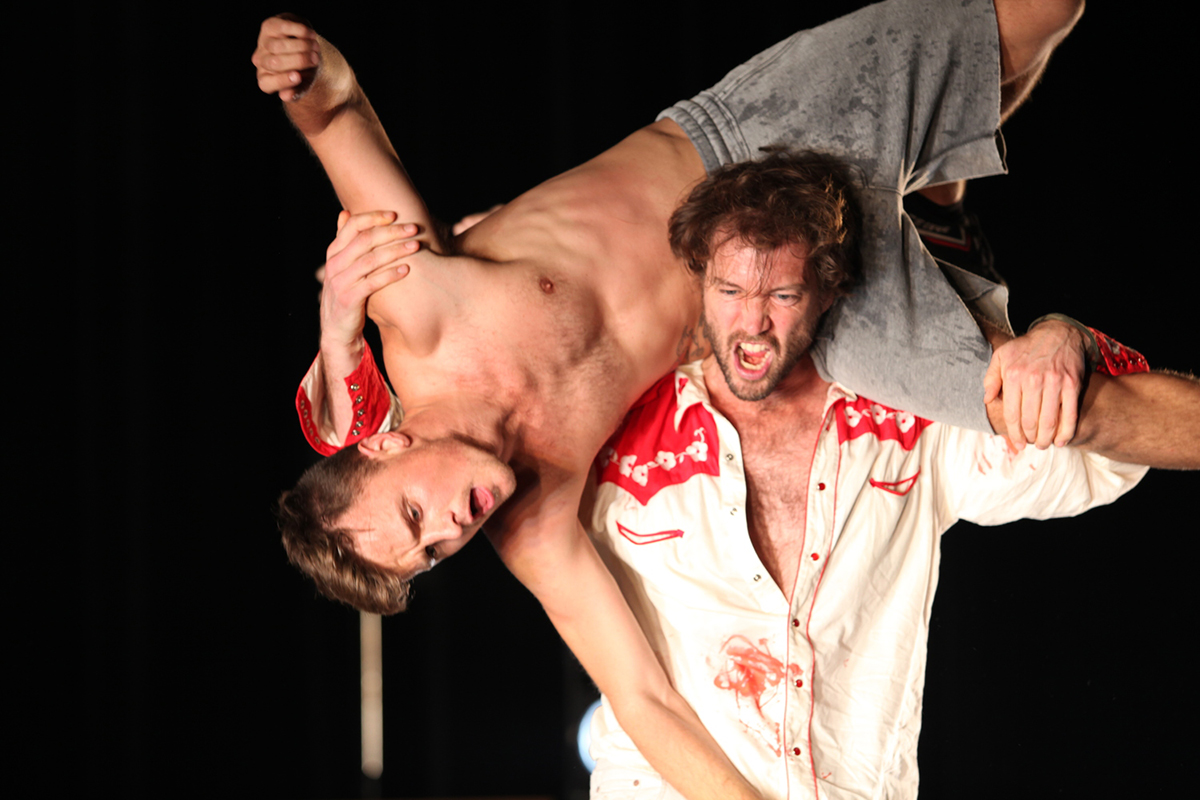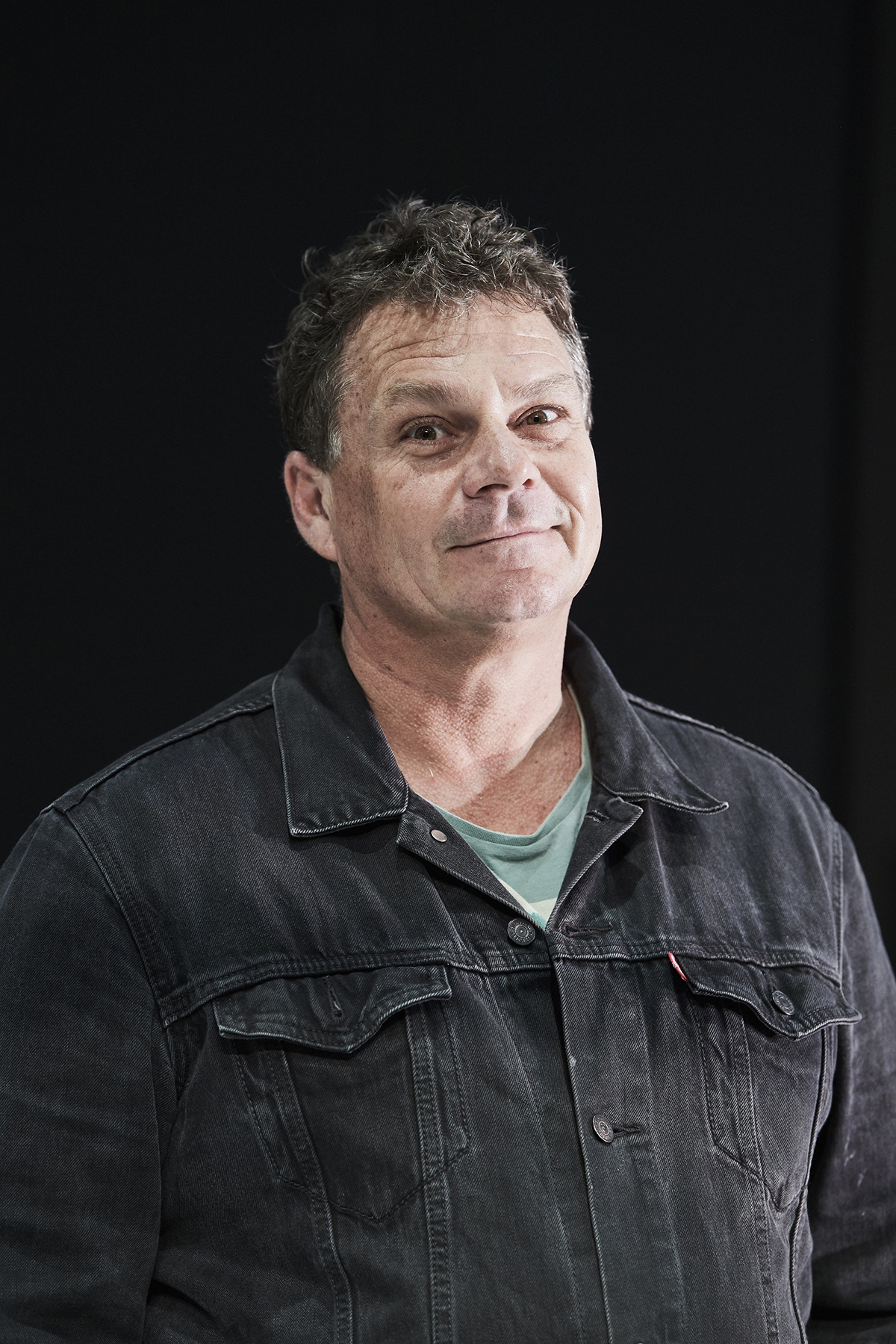Good Little Soldier, a work by Australian performance-maker Mark Howett first presented in Berlin and newly staged in Perth by Ochre Contemporary Dance Company and The Farm, deals with post-traumatic stress disorder in soldier veterans. After an opening scene set in an outback kitchen, we are briefly thrown back to Frank’s wartime experience in which he and his comrades capture a woman and a boy. Frank releases the boy to assist his colleague in pinning the woman to the floor. A bomb explodes and only Frank survives. The way in which his own family (wife Trish and son Josh) can be read as his enemies returned to haunt him is thus made clear.
Otherwise the work offers few allusions to either wartime experience itself or to how Frank recalls it. It is rather an exploration of the physical and emotional abuse that he inflicts on his family as a result of his trauma. The focus is therefore quite different from works like Angus Cerini’s Debrief (1999) or the National Theatre of Scotland’s Black Watch (2006), both of which included accounts of battlefield experiences and interviews with veterans about how events were replayed in their memories. One of the most terrifying stories Cerini related was how one man awoke with his hands around his wife’s throat. Good Little Soldier is in this sense an extended dramatisation of such later, domestic events. But what is actually occurring in Frank’s mind, or indeed the others’ minds, is only darkly refracted — rather than explicated — through his abusive behaviour.

Good Little Soldier, Ochre Contemporary Dance Company & The Farm, photo Peter Tea
The strength of the piece lies in the way it segues between domestic situations which could plausibly be occurring in a ‘real’ world, into unambiguously hallucinatory scenes. Frank is silhouetted against the window as his ghostly, white-attired dead comrades climb down the walls and suspend his squirming body in the air (crawling down walls has been a choreographic trademark of The Farm since Lawn, 2004; watch trailer here). In another striking sequence, Frank, spotlit from above in the darkness, pushes violently against Trish, before she is replaced by each of the ghosts, and then Josh, in a circling wrestling competition that cannot be resolved — the characters endlessly swapping places and matching each other. Choreographically, the piece is dominated by awkward, violent grappling and pushing: a messy rolling and bumping of bodies which form clumsy, writhing piles or temporarily balanced, off-centre structures, before tumbling down. As with Lawn and other works from The Farm, dancers hang off each other from unusual points, such as the head and neck. Faces seem more sites to push fingers into, or to wrap palms across, rather than sites of expressivity.
Good Little Soldier is episodic with each semi-pedestrian set of gestures, or slapping and physical configurations, caught in repetitive cycles. This has a nasty, imprisoned feel to it, but the production is otherwise somewhat flat emotionally. Frank finally raises his hand to strike Josh, and at one point he dons Trish’s dress before slamming himself repeatedly against the wall. These two acts of shocking violence against his loved ones, and, by implication, against himself (to hit Trish is also to hit himself), act as markers within the protagonist’s breakdown. But otherwise the transition from opening to conclusion is horizontal and open-ended. Each scenario is established before being repeated with minor variations, ending with an exhausted collapse, or a character’s departure. Dramatic development within scenes is rare, and their arrangement largely discontinuous. Therefore the affective content depends heavily on the superb music of Dale Couper and Matthew de la Hunty, together with Laurie Sinagra’s sound design — as is consistent with The Farm’s overall multimedia aesthetic.

Good Little Soldier, Ochre Contemporary Dance Company & The Farm, photo Peter Tea
Speakers are secreted beneath the seating banks such that leviathanic bass rumbles grind throughout the venue, engulfing audience and performer alike. This sense of the corrugated iron shed which the family inhabits as being something we too are trapped inside, is accentuated by regular entrances and exits through the auditorium, or a moment where a drunken Frank thumps under the seating, asking Trish to let him into the house. Couper and de la Hunty’s immersive score runs from low frequency noise music (signifying the war and moments where Frank slips into trauma), through to pulsing synthesisers recalling 1970s kraut-rock, distorted blues/country-and-western guitar solos, as well as manic junk percussion akin to early Hunters and Collectors (which featured Greg Perano on broken water heaters). The overall effect is like a more than usually theatrical gig from The Birthday Party.
The overall dramaturgy of Good Little Soldier feels at best loose. The expressivity of the work echoes instead the slightly rough aesthetic of the outback-style design, post-punk music and deliberately fumbling choreography. It functions more like a series of related installations. This is arguably the most ‘German’ aspect of the show (referred to by Mark Howett in a RealTime interview), placing it firmly within Hans Thies Lehman’s category of post–dramatic theatre. Good Little Soldier is best seen as a striking collection of thematically related set-pieces, giving the performance an absorbing sense of danger and possibility.
You can watch the Berlin production of Good Little Soldier below:
–
Ochre Contemporary Dance Company & The Farm, Good Little Soldier, concept, direction, lighting Mark Howett, choreography, text, performance Gavin Webber, Grayson Millwood, Ian Wilkes, Raewyn Hill, Otto Kosok, performers, music Dale Couper, Matthew de la Hunty, sound design Laurie Sinagra, dramaturg Phil Thomson, set, costume Bryan Woltjen; Subiaco Arts Centre, Perth, 9-30 July
Top image credit: Good Little Soldier, Ochre Contemporary Dance Company & The Farm, photo Peter Tea
Ochre Contemporary Dance Company is presenting a new production in Perth of Mark Howett’s Good Little Soldier, which premiered at Radialsystem V Berlin in 2013 to appreciative reviews. After working in Berlin for 12 years, Howett, a Nyoongar man, returned to Perth to be appointed Ochre’s Artistic Director. His international career in lighting design, including the Adelaide Festival-Sydney Theatre Company production of The Secret River and Katya Kabanova for Seattle Opera, has expanded into video design and directing. Howett was also a founding member of renowned performance ensemble The Farm, with Gavin Webber and Grayson Millwood who collaborated on the Berlin and Perth productions of Good Little Soldier.
For this his second production with Ochres (the first was Kaya in 2016), Howett is revisiting a very personal subject, Post Traumatic Stress Disorder (PTSD), which was suffered by his soldier father. Howett’s focus on the condition extends to its impact on partners and families and into the broader community. I spoke with him by phone.
What from your knowledge and experience — I understand you’ve had an instance of PTSD in your family — are the interior and exterior manifestations of the condition?
There’s the struggle of the sufferer. They don’t really want to give it out, to live it out and it manifests itself in physical symptoms, like sweating and palpitations. And hysteria is a way of dealing with trauma. We got really interested in the symptoms — like the tendency to shake or to see things as incredibly funny as a way to deal with it. Or they’ll get really remorseful and go completely internal, where they almost roll up into the foetal position.
Did you witness this yourself as a child?
I did, and at the beginning of making Good Little Soldier it was the way we got into some of the improvisations that became scenes and it was pretty cathartic for me to witness them. There were times when I found it difficult to watch. Then we started finding how some of those situations I went through were common to other families. Once we’d done consultations with organisations — like Partners of Veterans — and showings, families could come and have a say and then we fed that back into the piece. So whereas it started out with my experience, what my father’s behaviour was like, it went much more into dealing with the victims from the community’s point of view.
What was your approach to the material?
When I made this work in Berlin and it was after 12 years of living there, working as a designer and learning the German approach and their dramaturgy, I tried to get a lot of that into the way we made the work as well — a certain analytical viewpoint. I’d gone straight for the emotional in pieces I’ve made but the Germans take that away — they see it as embellishment. And they try to get to the heart of it. For example, they’ll use text in a devised work but they like to use text that the audience might know, say, a famous piece of writing about the war. When you hear those words you understand them, then you can go a step further with it in your thinking.
How do you translate the experience of PTSD, whether directly experienced by the subject or observed by family, into a stage language? There must be a leap when you’re no longer working literally?
That’s right. We try to get into it through triggers. We’ll show the incident in real time in a normal domestic scene and then use a trigger the soldier associates with the traumatic incident. That jumps us back with him — even if it’s for a few seconds — into what he’s experiencing and then back out into what is ‘normal.’

Berlin production, Good Little Soldier, photo Derek Kreckler
You’re pushing from a naturalistic scene into a heightened reality?
Yes. You get the context of what it might be like to suffer the repeating of the incident, over and over in the head. When sufferers experience it, they think they’re back there and it’s real — completely real. The trigger can be sound, it can be smell, it can be any of the senses that immediately puts them back there, even if it’s only seconds and then in the context of having to try to live a normal life when they return to be with the family. What would that be like in the middle of a normal day to suddenly be back in one of the most horrific incidents that you were involved in in the war? The family are sort of like good soldiers, ready to carry on and support him or her when they come home. They suffer it as well, because of the stress of that heightened awareness that happens within the home. You’re trying to be one step ahead of the sufferer so that they don’t experience a trigger or that you don’t cause it.
Is the trauma psychologically shared by partners and family?
I think it hits families multi-generationally. I think the suicide rate for children of veterans is higher than for veterans themselves.
You’re a Nyoongar man, you have a fellow Indigenous performer in the production and Ochre is an Indigenous and cross-cultural company. Indigenous soldiers would have suffered PTSD.
The actor Kelton Pell and I were talking about it and he said to me, “Come on, brother, all of us are suffering PTSD; it hasn’t stopped!” And that’s right. The repercussions for each generation are cumulative and really affect a whole community, let alone an individual family. That’s one of the big things we’re trying to say, that people suffering these big things unless we give them all the support we can, [trauma] can spread through the community as well. The repercussions of it, the dysfunctionality and the anguish as well for families. [Nyoongar actor, director and dancer] Ian Wilkes who is playing the ghost of a soldier is really fantastic. A really remarkable performance.

Mark Howett, photo Stefan Gosatti
Is this ghost a friend of the central figure?
Yes, and the incident is really a moral dilemma as well. Modern soldiers often have to go into domestic situations and deal with the public. There’s an even a greater dilemma for the soldier about killing. I was reading an amazing book that says only 10% of soldiers actually aim to kill. The rest aim to miss. It’s not within us to kill other people.
What’s the nature of the stage and sound design of Good Little Soldier?
The design by Bryan Woltjen is of a really isolated place that could be in the country or the city, pretty run-down, pretty dysfunctional — a bit like the family. And in the Subiaco Arts Centre theatre, we have a full 360-degree soundscape. The sound design becomes really important because noises are a very quick way of getting inside the mind of the sufferer. There’s a 21-gun salute, but it’s me doing a 21-gun salute for the innocents in the conflict. I also use video a lot in my work. I just came back from working with the Seattle Opera and filmed the countryside up there and I’m using it to help [convey traumatic] incidents as well.
And what do you hope your production will do for soldiers with PTSD and their families?
Well, obviously, beginning a conversation, building awareness that families can’t wear so much of the social cost and we have to help them in preventative ways. To the best of our ability, we must give them as much support as we can, as early as we can, so that the illness doesn’t become so prevalent and there’s a better chance of ensuring that they’re healthier people. It is about health really.
Is there anything you’d like to add about the production?
There is. The relationship with The Farm: Gavin Webber and Grayson Millwood. We’ve been long-term collaborators and I feel blessed to have worked with them and they’ve really encouraged me to develop myself as well. Part of the reason I’ve started directing is that when we were making work together in Europe, often I was the only person out front and I ended up having to do the notes on the performance. It eventually got to the stage where they’d say, “Mark, that’s enough. You’ve started directing, alright!” So, they encouraged me to go from being a lighting designer to be brave enough to conceive and develop my own work. The relationship I’ve had with them on the shows we’ve made like LAWN, Roadkill and Food Chain has been fantastic, supportive, awesome, funny, and I’m so lucky they’re part of the development of this new work. And in the same way, it’s happening in my work as a designer for Raewyn Hill, the Artistic Director of Perth’s Co3 dance company. It feels really healthy to interact with people that you’ve got history with in developing work. You know how they behave and you know their level of commitment. That they give it to you so generously is awesome.
–
Ochre Contemporary Dance Company with The Farm, Good Little Soldier, concept, direction Mark Howett, choreography, performance Grayson Millwood, Gavin Webber, Raewyn Hill, Otto Kosok, Ian Wilkes, dramaturgy Phil Thomson, design Bryan Woltjen, music Dale Couper, Matthew de la Hunty, Laurie Sinagra; Subiaco Arts Centre, Perth, 9-30 July
Top image credit: WA production, Good Little Soldier, photo Stefan Gossati
Over three days Perth’s MoveMe dance festival featured four major works, including the touring production of Force Majeure’s Never Did Me Any Harm. STRUT Dance, the National Choreographic Centre of Western Australia, provided the centrepiece, their young dancers performing under Batsheva Dance’s Artistic Director Ohad Naharin in a restaging of his Decadance (2000). The other two works I saw came from relatively new ensembles. New Zealander Raewyn Hill, who moved from Queensland’s Dancenorth to found Co3 in 2015, has made The Cry, while Praxis, a new collaboration comprising choreographer Laura Boynes, visual artist Alexander Boynes, composer Tristen Parr and five dancers premiered Dark Matter.
STRUT Dance: Decadance
Decadance is the most assured piece in the MoveMe program. STRUT’S dancers nail the complex, off-balance choreography. The work consists of 10 disparate studies of varying degrees of classicism. The choreography has a strong sense of line and precision, as well as an ambience of light sexual/erotic play (generally recalling Nederlands Dans Theater). Hip movements, especially from the women, often lead, and upright postures are broken by sweeping bends and crouches into the floor. The design is simple, including monochromatic, body-hugging jeans and tank tops. Pointe and partnering emerge, as do games with shoes. Arrayed in rows, dancers often run in parallel lines across the stage. When unison arises, the rippling responses recall a great machine, pushing the work into a focused ecstasy.
Decadance’s highlight, apart from its unbalanced, hip-rotating partnering, is an engrossingly cyclic explosion of Jewish ritual prayer. Sixteen dancers attired as Hasidim (including women in men’s black hats and suits) sit, legs apart, heads bowed, in a curve of chairs facing outwards. A drum-and-bass-remix of “Hava Nagila” is played (in a serious oversight, Naharin and STRUT do not credit the artists whose music is appropriated here). As the urge to move travels left to right, shoulders lift each body up in punching, diagonal gestures, before the chest explodes outwards and each dancer is thrown onto their feet, head and arms behind them. Each time this call runs through the chorus, the dancer at the far right is flung face down onto the stage, the sheer force of the appeal overwhelming him. This set of reflexes repeatedly plays out before the dancers throw away their chairs and tear off their shoes and shirts, creating a ‘bonfire of vanities’ at their feet. This eloquent display of the physicality of God’s call to man later segues into a perhaps overlong sequence where the dancers, back in their suits, draw audience members onto the stage to dance with them in a series of awkward but mostly touching tangos. While the deliberately kaleidoscopic nature of Decadance makes it an inconsistent journey, it is affecting and physically precise.
Co3, The Cry
Hill’s The Cry also had a sense of sharp, classical precision disturbed by low, sliding movements into the floor, together with an affective intensity derived from an apparently complex dramaturgical narrative behind the piece—though the ‘story’ remained opaque to me. While the piece certainly had an Expressionist tendency to produce gestures which suggested their origins in artesian sources of emotional complexity, this was countered by a remarkable blankness in the performers’ faces. Emotions stirred but characters and narratives were withheld, producing a charged but fundamentally abstract, semi-formal work.
This emphasis on inarticulate passion served the men best. Much of the action occurs between rows of chairs on either side of the stage, upon which impassive, lethargic dancers sit. Andrew Searle enters first, a vaguely Mephistophelian character in loose black clothing; a short but strong dancer who glides across the floor before rising up to pivot and place his torso facing the audience in a mute address. Others come and go but it is Co3’s tallest and most imposing dancer, Mitchell Harvey, who literally picks up and shoves his colleagues—notably Katherine Gurr, who repeatedly becomes a doll in his arms. This rather problematic gender construction is challenged at times, as when Harvey himself is ‘manhandled,’ but ultimately it is the men who get the best moves.
Such issues aside, the piece is notable for a clean, optically deceptive design from Hill. The rear wall consists of a sheet of vertical white corrugations. Under the largely consistent, white light of Mark Howett, this produces curious moiré illusions and distortions about the edges of the dancers. The performance is thus not only often explosively aggressive, but also has a meditative, mesmeric quality.
Musician Eden Mulholland is on stage throughout, guitar in hand. Thick soled boots elevate him above the dancers he observes. He crosses the stage several times, and at moments whispers vocals or plays keyboard. There is an ever shifting, grungy intensity to his contribution, metallic strums and string-bending accents giving a sense of modern disaffection to the piece.
Praxis, Dark Matter
The most experimental, if least successful, work in the festival was Dark Matter. The program note claims that the piece is inspired by everything from “human displacement” and “adaptation,” to how not only our “identities” but also our very “experiences” are “shaped” by the effects of “our environment,” be this the organic or social. Not surprisingly the work was dramaturgically lacking in cohesion. The choreography was also varied, drawing not only on Expressionism (in the suggestion of emotional states and a sense of groping towards an obscure symbolism) but also Contact Improvisation (rolling points of contact between bodies and climbing over each other), as well as general contemporary technique after Cunningham (more conventional moments of long lines and duets broken up by clawed gestures, less statuesque posing, dropping into the ground, and so on).
Dark Matter is excitingly framed. We first see a pair of tall, rectangular boxes. Material within rustles and billows upwards, driven by fans and bass speakers. The boxes are rolled into various positions and projections screened onto them. Several sequences feature digitally re-composed figures, which look as if they have been cast from green sand, including for some reason an oversized dog. The dancers frequently pause to gaze out, and the piece largely maintains a satisfying balance between a sense of dramatic resonance and simple formal play. The piece begins with the dancers slowly spreading rice in great drifts across the floor, and while interesting, once achieved, this central design element is largely ignored until the final sequence. Alison’s Halit’s To Run—Sand it was not.
Tristen Parr’s music combines cycling, glitchy digital tones with the sharp whine of an amplified cello. This infuses the typically subdued choreography with drive and shape—although the sound is poorly mixed. Still, Parr’s shuddering walls of noise are satisfying even when the cello is inaudible. For a new ensemble, Dark Matter is a fine start.
MoveMe is still a young festival, first staged in 2012 with works by Didier Theron, Sidi Larbi Cherkaoui and local artists and then followed with an intensive focus on improvisation in 2014. It will be interesting to see what influence the international improvisers of the 2014 MoveMe festival (see here and here) and the aesthetics of Ohad Naharin will have left way of legacy on local artists while C03 and Praxis emerge on their own trajectories.
—
Ausdance WA and partner companies: MoveMe 2016: Strut Dance, Decadance Perth 2016, choreography Ohad Naharin, lighting Avi Yona Bueno; Co3 Dance Company, The Cry, choreography, direction, design Raewyn Hill, music Eden Mulholland, lighting Mark Howett; Performing Lines WA, Praxis, Dark Matter, choreography Laura Boynes, music Tristen Parr, lighting Chris Donnelly, costumes Imogene Spencer, projection, design Alexander Boynes with Roly Skender; State Theatre Centre of Western Australia, Perth, 15-17 Sept
Top image credit: The Cry, Co3, MoveMe Festival, photo Stefan Gosatti



